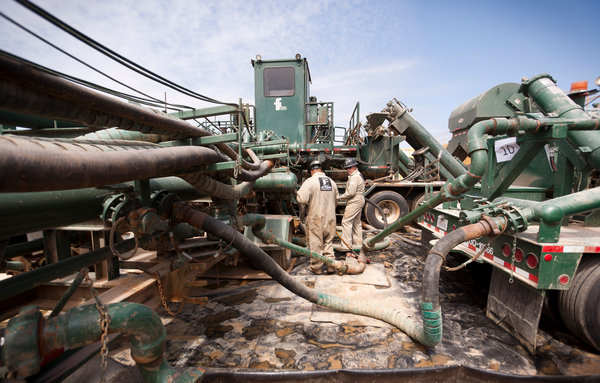|
By Erik Schiferle
Fracking, or hydraulic fracturing, is a natural gas collection process. The process requires the drilling of a well, which first descends vertically into shale rock layers between 6,000 and 10,000 feet underground and then continues horizontally for approximately one mile. Typically, a dilute acid mixed with thousands of gallons of water is pumped under high pressure into the well to create and open fissures in the shale rock surrounding the well. Then, a “slickwater mixture,” consisting of water, sand, and certain chemicals, is pumped into the well to further open and prop fractures. Fresh water is later pumped under high pressure to flush out the mixture. Natural gas escapes through the fissions and is collected at the surface. Each fracking rig and the chemicals used in the extraction process vary depending on the environmental conditions. But one fracking company website, to remain unnamed, lists some of the chemicals used in the fracturing process. The site lists household products in which some of the chemicals are found. However, the company does not list all of the chemicals and it makes no attempt to explain how the chemicals affect the environment or how they can be dangerous to humans. Tests done on fracking water have found chemicals such as hydrochloric acid, ethylene glycol, methanol, mapthalene, diesel fuel, benzene, ethylbenzene, and xylene, to name a few. Hydrochloric acid upon mixture with oxidizing agents can produce deadly chlorine gas. Ethylene glycol, commonly used for aircraft anti-freeze, upon ingestion can induce symptoms such as vomiting, drowsiness, coma, respiratory failure, convulsions, and renal damage. Methanol, if ingested, can break down into formic acid, which can cause permanent blindness by destruction of the optic nerve. Naphthalene, diesel fuel, and benzene are all classified carcinogens by the Environmental Protection Agency (EPA). Furthermore, ethylbenzene, and xylene are classified as suspected carcinogens by the EPA. Because hydraulic fracturing occurs primarily well below the surface of the earth, fracking companies claim that there is little to no environmental hazard. However, studies done in Pennsylvania have found all of the chemicals listed above at highly toxic levels in drinking water. Steve Lipsky of Texas claims that he is able to light his drinking water on fire because of fracking. He is not alone. The fracking company in question claimed that there is no proof that the drinking water was contaminated by the fracturing process directly. It also claims that residents in other areas, which do not have fracking rigs nearby, but have underground water aquifers near natural gas reserves, have also seen this phenomenon. For 4.2 million dollars, the fracking company is suing Steve for defamation. Experts argue that natural gas is a cleaner alternative to other hydrocarbon energy sources, such as coal, and that there is enough natural gas in the United States to power the entire country for the next 50 years. From a short-term economic standpoint, fracking could stimulate job growth and lower natural gas prices. However, without a better understanding of how fracking directly affects the environment, the benefits may not outweigh the costs of fracking. In defense of the fracking companies, some of the chemicals found at toxic levels in drinking water have yet to be directly linked to hydraulic fracturing: correlation does not necessarily mean causation. But, before companies continue to frack or at least before there is an increase in hydraulic fracturing, it may be worthwhile to determine if hydraulic fracturing is the cause of the contamination and how else it might affect the environment.
0 Comments
Leave a Reply. |
Categories
All
Archives
April 2024
|

